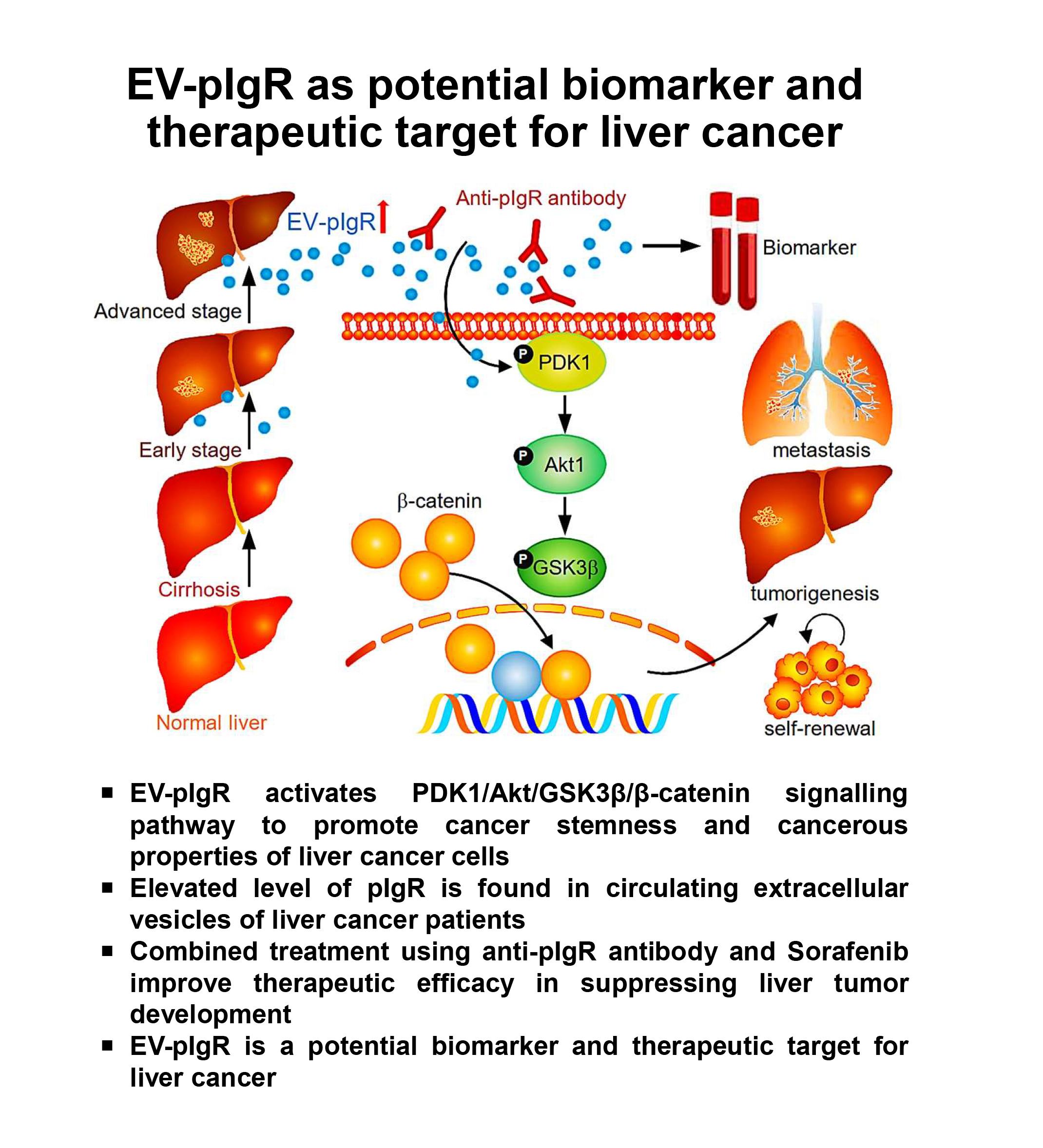26 January 2022
A research team at the Department of Pathology, LKS Faculty of Medicine, The University of Hong Kong (HKUMed) in collaboration with Hong Kong and Mainland researchers has revealed an unrecognised function of patient-derived circulating extracellular vesicles (EVs) in liver cancer metastasis. These ground-breaking findings giving insights into early diagnosis and new therapeutic strategy for liver cancer are now published in Journal of Hepatology, the leading journal in the field of gastroenterology and hepatology. [link to the publication]
Background
Liver cancer is the sixth most common cancer and the third leading cause of cancer related death worldwide. It is highly prevalent in Mainland China and Hong Kong. Surgery remains the mainstay of treatment. Liver cancer can be asymptomatic in the early stage, which explains why liver cancer patients are often diagnosed at the advanced stage and precluded from curative treatment. Poor prognosis of liver cancer patients highlights the need to have promising biomarkers for early diagnosis and reinforces the necessity for a better understanding of the mechanistic basis of this deadly disease, in order to develop effective therapeutics for the patients.
Research methods and findings
Using proteomic profiling to compare circulating EVs obtained from the sera of control individuals and liver cancer patients at early and advanced stages, the team discovered a stepwise upregulation of polymeric immunoglobulin receptor (pIgR) in the circulating EVs from control individuals, cancer patients at the early stage to those at the advanced stage. The level of EV-pIgR decreases in about 70% of patients after surgery. These findings suggest the crucial role of EV-pIgR in liver cancer development and its potentiality as a non-invasive diagnostic marker for liver cancer.
The research team further demonstrated the functions of pIgR-enriched EVs, obtained from serum of cancer patient and metastatic liver cancer cell line, in promoting cancer stemness, tumorigenesis and metastasis in mouse model of liver cancer. The oncogenic effect of EVs is dramatically compromised when the expression or function of pIgR is suppressed. The team also unravelled the molecular mechanism by which EV-pIgR activates PDK1/Akt/GSK3β/β-catenin signalling axis in cancer cells.
Sorafenib is the first-line systemic treatment for advanced inoperable liver cancer. The team showed that combined treatment using anti-pIgR antibody and sorafenib is more effective than sorafenib alone in inhibiting tumour development in a patient-derived xenograft mouse model. The outcome suggests an alternative effective therapeutic approach for cancer patients.
Research significance
The team has made a major breakthrough in elucidating the role of pIgR carried by EVs of liver cancer patients as a key modulator of tumour progression with clinical relevance and applications. The circulating nature of EV-pIgR and its correlation with tumour stage suggest the potential application of EV-pIgR as a non-invasive biomarker for liver cancer.
‘Our study has identified pIgR as a key component in extracellular vesicles that functions as a potent promoter of liver cancer. The potential utilisation of EV-pIgR as biomarker may improve early diagnosis so as to increase the opportunity of cancer patients to receive curative treatment. Furthermore, our findings also demonstrated that targeting pIgR alone or in combination with other drugs is an effective treatment for inhibiting liver cancer development,’ said Dr Judy Yam Wai-ping, Associate Professor of the Department of Pathology, HKUMed, who led the research.
About the research team
The research was led by Dr Judy Yam Wai-ping, Associate Professor of the Department of Pathology, HKUMed. Dr Tey Sze-keong, Postdoctoral Fellow and Mr Samuel Wong Wan-ki, PhD student, Department of Pathology, HKUMed, are co-first authors, with assistance from Ms Janice Chan Yuen-tung, Dr Mao Xiaowen, Research Assistant Professor, Dr Ng Tung-him, Ms Cherlie Yeung Lot-sum, Ms Zoe Leung and Ms Fung Hui-ling. Collaborators include Dr Alexander Tang Hin-ning, Clinical Assistant Professor, Dr Albert Sin Chun-fung, Clinical Assistant Professor, and Professor Irene Ng Oi-lin, Loke Yew Professor in Pathology, Chair Professor of Pathology of the Department of Pathology, HKUMed; Dr Danny Wong Ka-ho, Scientific Officer, Dr Loey Mak Lung-yi, Clinical Assistant Professor, and Professor Yuen Man-fung, Li Shu Fan Medical Foundation Professor in Medicine, Chair and Chief of Division of Gastroenterology and Hepatology, Deputy Head of the Department of Medicine, HKUMed; Dr Stephanie Ma Kwai-yee, Associate Professor of the School of Biomedical Sciences, HKUMed. Collaborating institutions contributing to the research include The Hong Kong Polytechnic University, Sun Yat-sen University Cancer Center and Southern Medical University, Guangzhou.
Acknowledgement
The work was supported by the Hong Kong Research Grants Council Theme-based Research Scheme on Liver Cancer Stemness (Project No. T12-704/16-R) and the Seed Funding for Strategic Interdisciplinary Research Scheme (Project no.: 102009863 and 007000142) from The University of Hong Kong.
Media enquiries
Please contact LKS Faculty of Medicine of The University of Hong Kong by email (medmedia@hku.hk).



Follow HKUMed